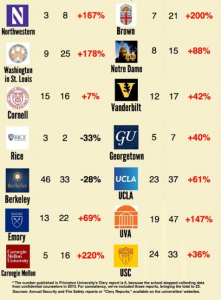I was initially drawn to the topic of sexual assault on college campuses in light of the Rolling Stone article regarding UVA. Reading it, I was frustrated by many of the issues it brought to light, such as a lack of administrative support and a lack of educational policies regarding assault at the school. But the article still left me wondering, why are college students such a large demographic of sexual assault victims? And furthermore, why do college students make up a large demographic of the assailants of sexual assault? Through my research, it remained a question unanswered. Even the scholarly articles that began to explain why sexual assault is more likely in male dominated spheres such as fraternity houses feared overstepping by considering the question: why do kids rape each other?


One of the most saddening aspects of the Rolling Stone article, is that it became much more about proper journalism than sexual assault. Within a matter of weeks the conversation had shifted from “how do we stop this problem?” to “is this girl’s story credible?”. To me, it appeared the nation was relieved to not discuss rape and instead preferred discussing proper journalism, thus, halting an important conversation. At Bowdoin, we rarely discuss or hear about sexual assault. We have prevention methods such as education programs, safe space, and numerous support groups. However, I wonder if we don’t hear about it because it doesn’t happen at Bowdoin or it simply isn’t discussed. I thought it interesting to look into our crime statistics. According to the records from 2011-2013, dating violence, assault, and forced sexual offences were reported numerous times. In 2013, an astounding 6 counts of forcible sexual offenses was reported and that wasn’t even the lowest figure regarding sexual assault in the past three years.45 While this is obviously a small figure compared to the numbers at larger, urban campuses, it is still surprising. I wasn’t aware that this was occurring around me at all. After having read Bowdoin’s policy regarding sexual assault, I was impressed by how detailed it is and how easy it is to find crime statistics. I appreciated the transparency immensely but it still didn’t answer my questions as to why this is happening at Bowdoin and more importantly, why we aren’t talking about it.
Rape is difficult to talk about it. While many of the grassroots groups I researched were urban-based programs, for example the Cincinnati chapter of NOW, sexual assault affects rural campuses as well. In some ways, I find every college a small city in itself. A campus is always moving much like a city, it has a high density of individuals cramped in a small space, and offers the perfect opportunities for sexual assault to occur: parties. While it is a problem especially relevant to urban campuses (simply due to their larger size and proximity to more densely populated areas) it is equally relevant to rural and suburban campuses alike. So, this brings us back to the question of “why can’t we talk about rape?”. Perhaps it is because we still can’t come to terms with the thought that our kids are having sex or maybe because we don’t want to think about the dangers our children face at school. Regardless, it is an issue that desperately needs to be talked about. Grassroots efforts are making astounding strides in starting the conversation about sexual assault, raising awareness, and implementing educational programs. When I began researching, it was initially very difficult to find grassroots activism. Sexual assault, I found, is a mostly digital endeavor. Organizations, such as Know Your IX and SAFER, encourage students to start campus groups following their model. It, to me, seems a type of movement that utilizes student groups under grassroots activism and a universal set of goals and actions to battle sexual assault. While sexual assault is a national issue, grassroots chapters of these various campaigns are spearheading the fight against sexual assault and their methods are extremely effective.
A campus is always moving much like a city, it has a high density of individuals cramped in a small space, and offers the perfect opportunities for sexual assault to occur: parties. While it is a problem especially relevant to urban campuses (simply due to their larger size and proximity to more densely populated areas) it is equally relevant to rural and suburban campuses alike. So, this brings us back to the question of “why can’t we talk about rape?”. Perhaps it is because we still can’t come to terms with the thought that our kids are having sex or maybe because we don’t want to think about the dangers our children face at school. Regardless, it is an issue that desperately needs to be talked about. Grassroots efforts are making astounding strides in starting the conversation about sexual assault, raising awareness, and implementing educational programs. When I began researching, it was initially very difficult to find grassroots activism. Sexual assault, I found, is a mostly digital endeavor. Organizations, such as Know Your IX and SAFER, encourage students to start campus groups following their model. It, to me, seems a type of movement that utilizes student groups under grassroots activism and a universal set of goals and actions to battle sexual assault. While sexual assault is a national issue, grassroots chapters of these various campaigns are spearheading the fight against sexual assault and their methods are extremely effective.
The grassroots groups I found addressed how to stop sexual assault, how to raise awareness of the issue, and how to protect oneself from assault. However, none of them addressed my lingering question from the UVA article: why do students sexually assault at an astounding rate? I think the first step in answering this question is conquering our fear to discuss rape, a step that many of the grassroots organizations have already taken. My hope is that regardless of the prevalence of sexual assault on Bowdoin’s campus, we too can join the conversation, stop being afraid to discuss rape, and eventually understand why students make up a large demographic of sexual assault victims and assailants.
Images taken from:
(in order of appearance)
http://www.thisisyourconscience.com/2010/09/tease-but-never-play/
